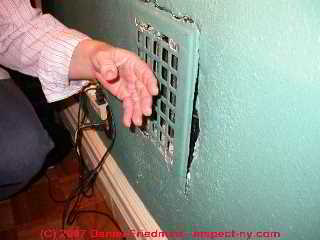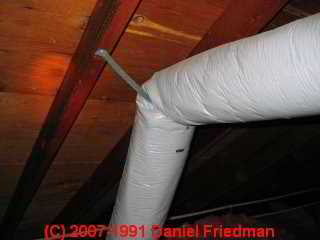 Find & Fix Air Conditioning or Heating Supply Air Duct Leaks or Obstructions
Find & Fix Air Conditioning or Heating Supply Air Duct Leaks or Obstructions
- POST a QUESTION or COMMENT about inadequate supply air in HVAC duct systems and its effect on heating or cooling air flow adequacy
Guide to heating & cooling duct work supply air flow adequacy, flow rate, temperature, and related problems.
This chapter of "How to Inspect the Central Air Conditioning or Cooling System" describes the inspection of heating and air conditioning (HVAC) duct registers & zones for defects such as missing air conditioning cool air supply or return air registers, undersized air conditioning duct openings, improper cooling duct routing, cooling (or heating) air duct corrosion, leaky air duct connections, defective heating or cooling ductwork materials such as Goodman gray flex-duct, some Owens Corning Flex-duct, and asbestos-containing air conditioning or heating duct work.
The photograph above shows a 1930's heating and cooling air supply register still in active use, but with leakage around the register which transmitted odors and mold from the building basement.
InspectAPedia tolerates no conflicts of interest. We have no relationship with advertisers, products, or services discussed at this website.
- Daniel Friedman, Publisher/Editor/Author - See WHO ARE WE?
HVAC Supply Air Duct Leaks & Obstructions - Theory & Practice
 Blockages or crimps in HVAC ducts (photo at left) restrict air flow and in severe cases can cut it off entirely.
Blockages or crimps in HVAC ducts (photo at left) restrict air flow and in severe cases can cut it off entirely.
Leaks in HVAC cooling or heating air supply ducts mean that cooling or heating costs are increased, since the HVAC system needs to run longer to reach the desired indoor temperature and humidity.
[Click to enlarge any image]
Where more severe supply air duct leaks are occurring, some areas of the building or even the entire building may receive no heated or cooled air at all, even though the equipment is running.
List of Articles giving Procedures for Diagnosing HVAC System Air Leaks & Air Flow Problems
Below we list a catalog of common explanations for inadequate air flow from an HVAC duct system.
Watch out: But keep in mind that even this apparently accurate calculation of the effect of piping on air pressure and airflow loss will not include the effects of leaks or obstructions in the building return air or supply air duct system such as the following:
- Air filter or other item that has been sucked into the duct system will block air flow and can risk a fire if drawn into the blower assembly fan, DIRTY AIR FILTER PROBLEMS are perhaps the most common cause of unsatisfactory airflow in an HVAC system.
- Blower Fan: dirty blades on a squirrel cage blower assembly fan significantly reduce the blower fan's ability to move air into the HVAC system from the return-air side as well as reducing its ability to push conditioned air into the occupied space.
See DIRTY A/C BLOWERS - Fire damper that has become stuck in the closed or partly-closed position interferes with proper airflow through the system
See FIRE & SMOKE DAMPERS, AUTOMATIC - Flex duct defects: Collapsed sections of flex duct block or stop airflow in either supply or return air systems
See DUCT ROUTING & SUPPORT (see our photo, above-left). - Insulation loose in air ducts: Collapsed duct interior insulation
See FIBERGLASS DUCT, RIGID CONSTRUCTION - Leaks in the supply air duct system are a very common HVAC duct defect that results in poor heating or cooling air flow.
See LEAKY DUCT CONNECTIONS
Return air inlets: Return air inlet grilles that are obstructed with dirt, debris, or furniture or that are improperly located or are just too small mean that because the heating or cooling system is "starved for air", the supply air flow into occupied spaces will also be reduced. RETURN AIR REGISTERS & DUCTS
- Transite air ducts: Crushed or collapsed transite duct
See TRANSITE PIPE AIR DUCT ASBESTOS RISKS - Zone dampers that are stuck partly closed obstruct air supply into that building area, or if stuck "open" when the zone damper should be closed, airflow to other building areas will be reduced.
See ZONE DAMPER CONTROLS - Also see UNDERSIZED RETURN DUCTS.
...
Reader Comments, Questions & Answers About The Article Above
Below you will find questions and answers previously posted on this page at its page bottom reader comment box.
Reader Q&A - also see RECOMMENDED ARTICLES & FAQs
Question: AC system suddenly quit delivering supply air to some rooms in the building
(June 29, 2011) pam
I am trying to troubleshoot an a/c system that overnight quit supplying air to the upstairs and two rooms downstairs. (coil is fine, air handler/blower operating fine, no observable fault of (exterior) duct system. the rooms without air are getting none at all.
Reply:
I'd look for:
- a damper that someone closed in the ductwork
- a filter that came loose and blew into the ductwork
- a duct that came disconnected
- a flex duct that had something fall on it, squashing it shut
Question: ok to run supply air ducts inside of cold air returns?
(May 2, 2012) rbprivate1@gmail.com
can supply ducts be run within cold air returns? I was inspecting a new home being built in my area and noticed several areas where there were heat ducts running within cols air returns for a substantial length. Does this comply with codes?
Reply:
RBprivate
The only place where running coaxial heating ducts makes any sense to me is within an air to air heat exchange system.
For example, if a building is bringing in fresh outdoor air and also exhausting stale indoor air, we may run one duct inside the other in order to transfer heat in the desired direction, thus reducing building energy costs.
May 2, 2012) Supply duct inside a return return
I noted at least two instances in the new home where supply ducts were inside a return air joist spaces between the floor joist. wondered if this was within code. These were inside for a distance of ten or more feet. Looks like in cooling season these supplies would probable become a huge area for condensation to form and drip. This also would greatly reduce the volume of air the retun may have.
Reply:
Building codes often cannot and do not try to anticipate every snafu that people can imagine, instead specifying overall performance objectives.
Running a supply air duct inside of a return air passage transfers energy between the two, as we explained above. If we are only talking about recirculating building air rather then the impact on overall heating or cooling costs may be minimal, certainly of less impact than running either supply or return ducts through unconditioned space, particularly if the ducts are not well insulated.
In my OPINION there is also a risk of un-detected cross-leakage out of supply into return ducts that might reduce the effectiveness of the system.
Question: need to replace collapsed flex-duct
(Jan 9, 2013) Larry
If a flexible supply duct under our double wide has a 6' collapsed section, does it need replaced?
Reply:
Certainly yes, Larry. Otherwise you are restricting air supply to the living area and increasing heating & cooling costs.
...
...
Continue reading at LEAKY DUCT CONNECTIONS or select a topic from the closely-related articles below, or see the complete ARTICLE INDEX.
Or see AIR LEAKS in DUCTWORK FAQs diagnostic questions & answers posted originally at this page.
Or see these
Recommended Articles
- AIR FLOW TOO WEAK
- AIR LEAK NOISES
- AIR LEAKS in DUCT CONNECTIONS
- AIR LEAKs in SUPPLY DUCTS
- AIR LEAKS in RETURN DUCTS
- AIR FLOW IMPROVEMENT, HVAC
- AIR FLOW MEASUREMENT CFM - how to measure HVAC system air flow
- DUCT SYSTEM DESIGN SIZE & DEFECTS - home
- ENERGY AUDIT STANDARDS for ENERGY RATINGS how HVAC system air leaks are measured & quantified
- RETURN AIR, INCREASE
- REGISTER & DUCT LOCATION
- RETURN AIR FAQs
- RETURN AIR REGISTERS & DUCTS - home
- UNDERSIZED RETURN DUCTS
Suggested citation for this web page
SUPPLY DUCT AIR LEAKS at InspectApedia.com - online encyclopedia of building & environmental inspection, testing, diagnosis, repair, & problem prevention advice.
Or see this
INDEX to RELATED ARTICLES: ARTICLE INDEX to HVAC DUCT SYSTEMS
Or use the SEARCH BOX found below to Ask a Question or Search InspectApedia
Ask a Question or Search InspectApedia
Try the search box just below, or if you prefer, post a question or comment in the Comments box below and we will respond promptly.
Search the InspectApedia website
Note: appearance of your Comment below may be delayed: if your comment contains an image, photograph, web link, or text that looks to the software as if it might be a web link, your posting will appear after it has been approved by a moderator. Apologies for the delay.
Only one image can be added per comment but you can post as many comments, and therefore images, as you like.
You will not receive a notification when a response to your question has been posted.
Please bookmark this page to make it easy for you to check back for our response.
Comments
IF above you see "Comment Form is loading comments..." then COMMENT BOX - countable.ca / bawkbox.com IS NOT WORKING.
In any case you are welcome to send an email directly to us at InspectApedia.com at editor@inspectApedia.com
We'll reply to you directly. Please help us help you by noting, in your email, the URL of the InspectApedia page where you wanted to comment.
Citations & References
In addition to any citations in the article above, a full list is available on request.
- Engineering toolbox properties of water - http://www.engineeringtoolbox.com/water-thermal-properties-d_162.html and email: editor.engineeringtoolbox@gmail.com web search 09/16/2010
- FIBERGLASS HAZARDS Indoor Air Quality Investigations: Fiberglass in Indoor Air, HVAC ducts, and Building Insulation
- In addition to citations & references found in this article, see the research citations given at the end of the related articles found at our suggested
CONTINUE READING or RECOMMENDED ARTICLES.
- Carson, Dunlop & Associates Ltd., 120 Carlton Street Suite 407, Toronto ON M5A 4K2. Tel: (416) 964-9415 1-800-268-7070 Email: info@carsondunlop.com. Alan Carson is a past president of ASHI, the American Society of Home Inspectors.
Thanks to Alan Carson and Bob Dunlop, for permission for InspectAPedia to use text excerpts from The HOME REFERENCE BOOK - the Encyclopedia of Homes and to use illustrations from The ILLUSTRATED HOME .
Carson Dunlop Associates provides extensive home inspection education and report writing material. In gratitude we provide links to tsome Carson Dunlop Associates products and services.

